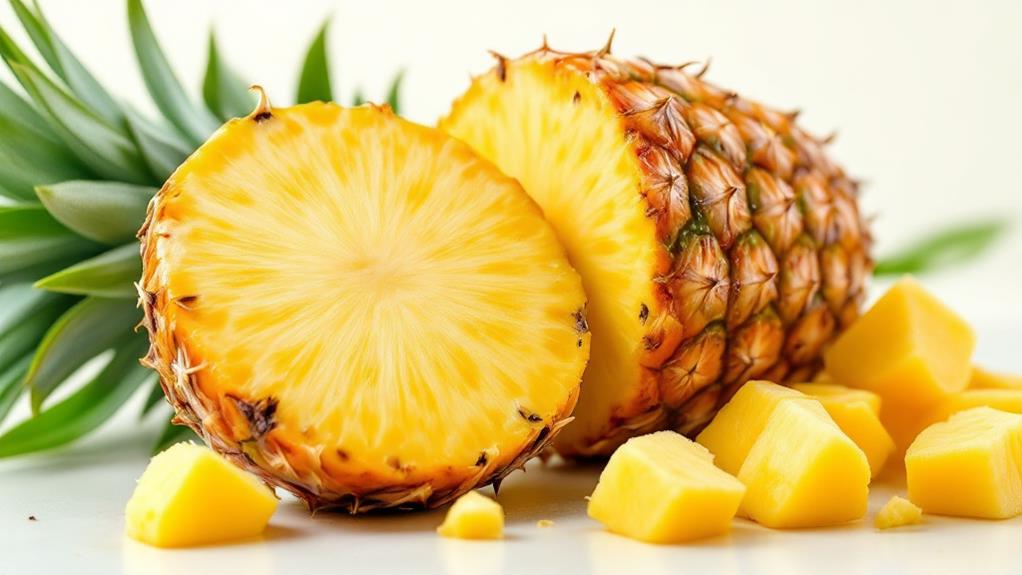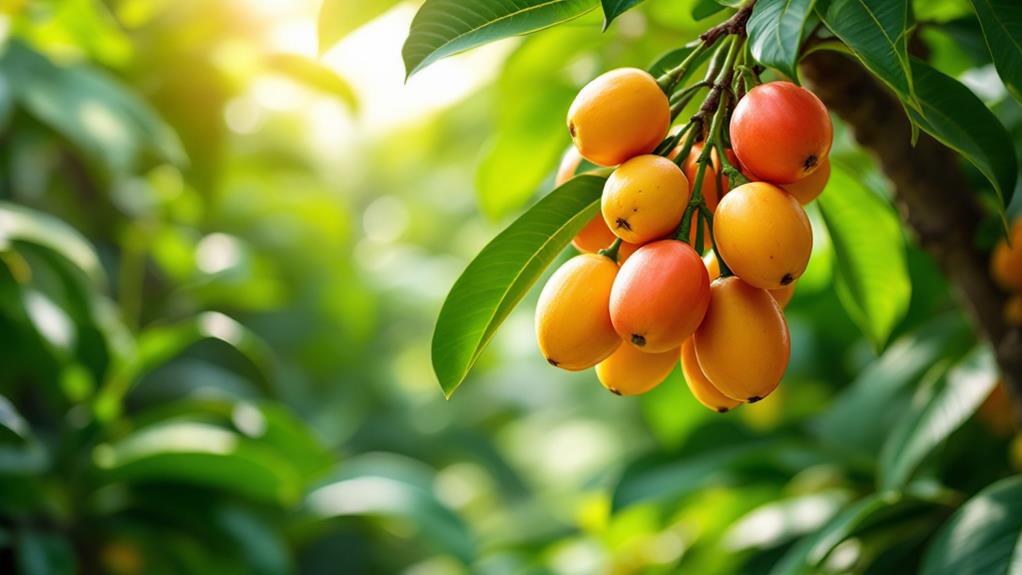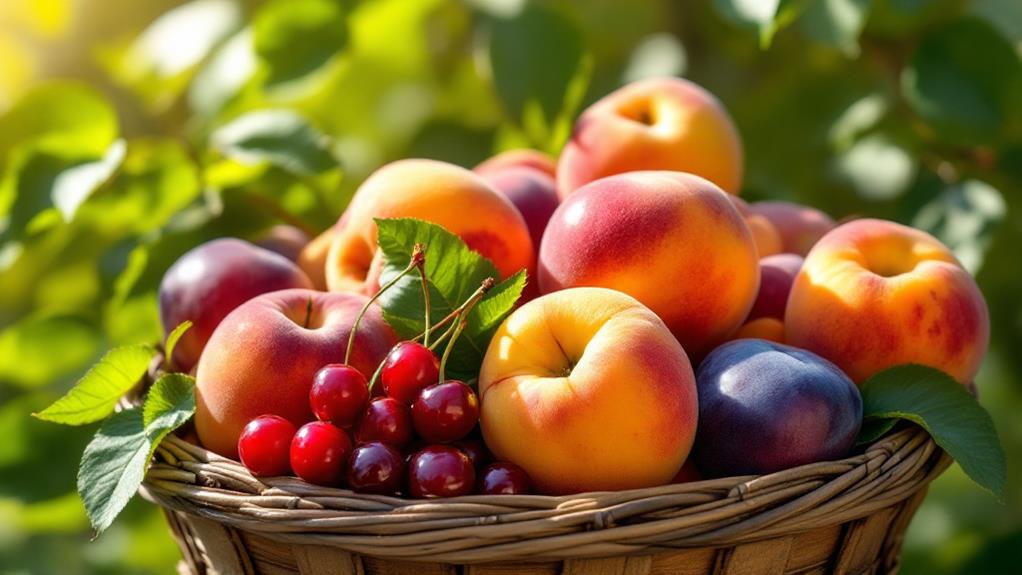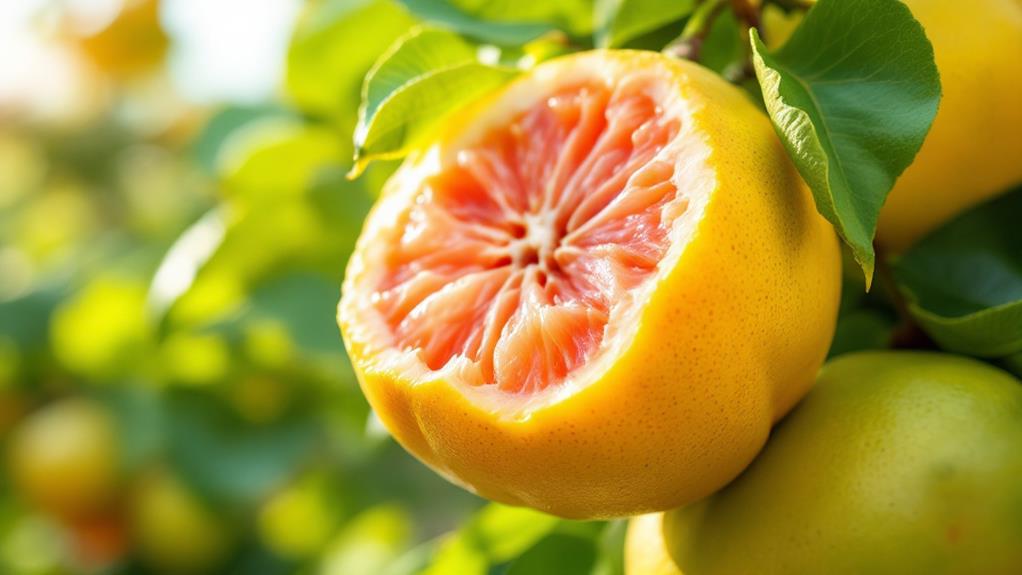22 Interesting Facts About Apples You Didn’t Know
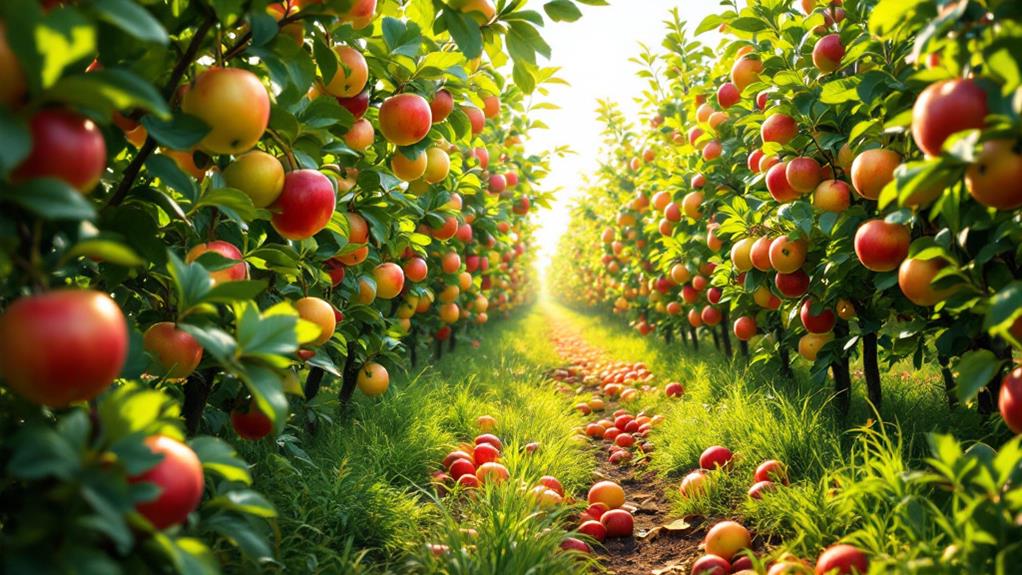
You're about to uncover some intriguing apple facts you probably didn't know. Apples, originating from Kazakhstan, boast over 7,500 varieties worldwide. Washington State supplies over 60% of U.S. apples, exporting to 60 countries. A medium apple offers 4 grams of dietary fiber and contains 85% water, making it a hydrating snack. Surprisingly, apple seeds aren't as toxic as you've heard—it would take around 200 seeds for toxicity. Apples' air composition makes them float, a fun fact you can see in apple bobbing. They'll also find connections to American identity and fairy tale symbolism enchanting. For more apple wonders, continue on!
Apple Production Worldwide
Apple production is a significant global agricultural endeavor, with 2020 seeing a staggering 86 million tonnes produced worldwide. When you consider apple production, it's fascinating to note that nearly half of this colossal output comes from China. As the world's largest apple producer, China plays a central role in supplying this beloved fruit globally. Meanwhile, in the United States, apple production is heavily concentrated in Washington State, which is responsible for over 60% of the apples consumed domestically. This makes Washington a key player in the American apple industry.
If you're curious about where apples thrive, it's essential to know that they're cultivated in temperate climates. They require well-drained soil to guarantee the best growth conditions. As someone interested in apple production, you'll find that careful management is vital to optimizing both yield and quality. This involves everything from choosing the right soil and climate to managing pests and diseases.
With more than 7,500 cultivated apple varieties worldwide, apple production showcases a remarkable diversity. However, the focus remains on maximizing output and maintaining the quality that makes apples a staple in diets across the globe.
Varieties of Apples
When exploring the world of apples, you'll uncover a staggering 7,500 varieties cultivated globally, each offering unique tastes, textures, and colors. In the United States, around 2,500 of these varieties of apples flourish, with Washington state being a prominent player, featuring eight primary types among over 30 varieties. This diversity is a reflection of the adaptability and widespread appeal of apples.
Among the popular varieties of apples, Fuji, Gala, and Granny Smith stand out. Each has been developed for specific climates, making them perfect for different culinary uses. Regardless of you're baking a pie or enjoying a crisp snack, there's an apple variety to match your preference. Trying every variety would be an overwhelming task, taking about 20 years to experience them all—highlighting the extensive range available to consumers.
The genetic diversity within these apple cultivars plays an essential role in food security. It helps protect against pests and diseases that could impact apple production. So, next time you bite into an apple, remember the rich variety and genetic history it represents. You're not just tasting a fruit; you're enjoying a piece of agricultural heritage and innovation.
Nutritional Insights
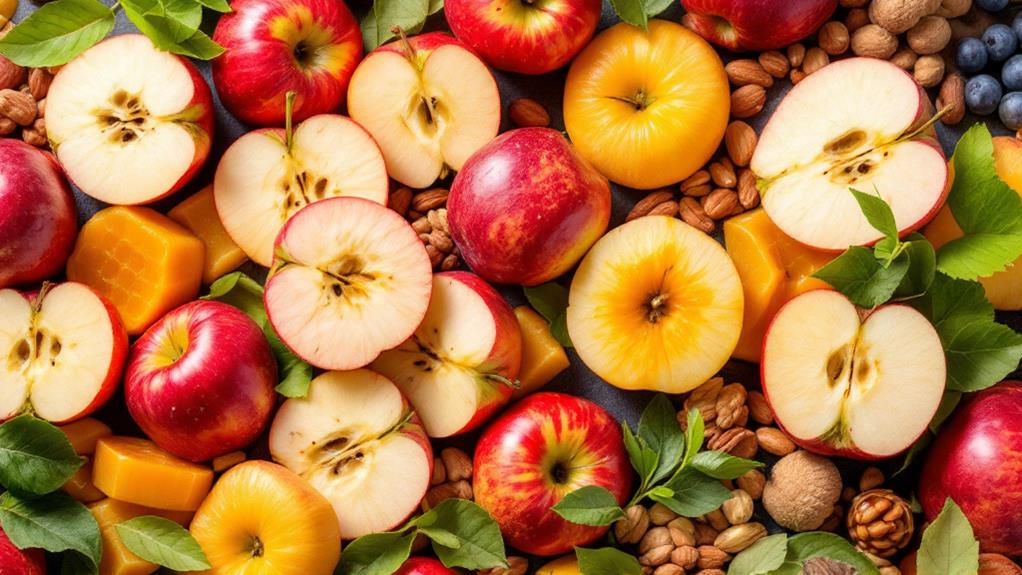
Incorporating apples into your diet offers a multitude of nutritional benefits. When you bite into a medium-sized apple, you're getting about 4 grams of dietary fiber, which is a remarkable 17% of your daily fiber needs. This fiber content aids digestion and supports heart health. Despite their sweet taste, apples are low in calories, with an average apple containing just 95 calories, making them an ideal snack to maintain a balanced diet without excessive calorie intake.
One of the key nutritional insights is that, although apples aren't the richest in vitamin C, they excel in other nutrients. An average apple provides only about 4% of your daily vitamin C requirement, much less than a potato. However, the real magic lies in the antioxidants apple contains, such as quercetin and procyanidins. These compounds help combat oxidative stress, potentially reducing the risk of chronic diseases.
Regular apple consumption has been linked to a lower risk of heart disease and cancer, thanks to their fiber and antioxidant content. By choosing apples, you're opting for a natural way to enhance your health, improve digestion, and support general well-being.
Apple-Related Measurements
While the nutritional benefits of apples are impressive, understanding their diverse measurements can improve your appreciation for this versatile fruit. It's fascinating to see how apple varieties can influence these measurements. Did you know that a bushel of apples weighs about 42 pounds? This hefty amount can yield roughly 21 pies, 3 gallons of cider, or 20 quarts of applesauce. The variety and size of apples play a significant role here. For instance, an average apple weighs between 100-150 grams. That means a smaller variety like a Gala might weigh less than a larger Honeycrisp.
When it comes to cider, you'd need about 36 apples to produce a single gallon. Considering the average American consumes around 16 pounds of fresh apples annually, that's a lot of cider potential! Plus, an apple tree's productivity is impressive, yielding around 500 to 800 apples per season depending on the variety and the tree's health.
Here's a quick breakdown of apple-related measurements:
- A bushel of apples: ~42 pounds
- Average apple weight: 100-150 grams
- Apples per gallon of cider: ~36
- Annual apple consumption per American: ~16 pounds
- Apples produced per tree per season: 500-800
Understanding these measurements can help you better appreciate the weight and worth of your favorite apple varieties.
Growth and Harvesting
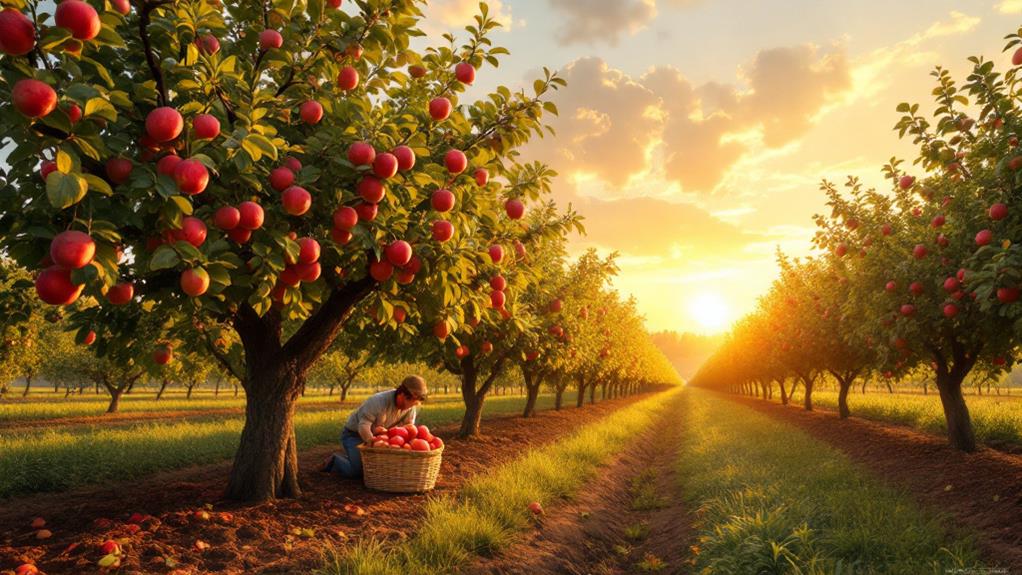
Apple cultivation is a careful process requiring patience and expertise. If you decide to grow apple trees, you'll find they usually take between 4 to 10 years to reach full production, depending on the variety and specific growing conditions. It's a rewarding endeavor, but it demands careful management of sunlight, water, and fertilizer to guarantee your apple trees produce the best yield possible. Without proper care, reaching ideal fruit production becomes challenging, impacting both quantity and quality.
The prime time for harvesting apples is during September and October. This period is when apples are at their peak ripeness, assuring the best texture and flavor. During these months, apple orchards come to life with activity as growers and enthusiasts alike engage in seasonal apple picking. You'll find over 20 different apple varieties available, offering a diverse range of flavors for every palate.
Proper orchard maintenance is vital for sustaining apple production over the years. Regular pruning, pest management, and soil care help in keeping your apple trees healthy and productive. With dedication, you'll enjoy not only the fruits of your labor but also the satisfaction of nurturing these trees to their fullest potential.
Historical Origins
Long before apples became a staple in global diets, they originated in the wild landscapes of Kazakhstan, where Malus sieversii, their ancestor, still thrives. This wild apple tree provided the foundation for the many varieties we enjoy today. You might be surprised to learn that humans have been munching on apples for over 8,500 years. This makes them one of the earliest fruits to be cultivated. As you wander through history, you'll uncover that the scientific name for your average apple, Malus domestica, reflects its cultivated nature, with "malus" stemming from the Greek word for fruit.
When European settlers arrived in North America, they brought apple seeds along, paving the way for the initial recorded cultivation in the New World. Thanks to figures like Johnny Appleseed, the apple tree spread its roots across the United States, enriching the agricultural landscape. Apple's cultural expedition also spans across the ocean. Did you know that apple pie, often seen as an American classic, actually hails from England, dating back to the 1300s?
Here's a quick peek into some intriguing apple facts:
- Apples were among the earliest cultivated fruits.
- Malus sieversii is the ancestor of modern apples.
- Johnny Appleseed popularized apple trees in the U.S.
- The scientific name is Malus domestica.
- Apple pie originated in England.
Native Apple Varieties
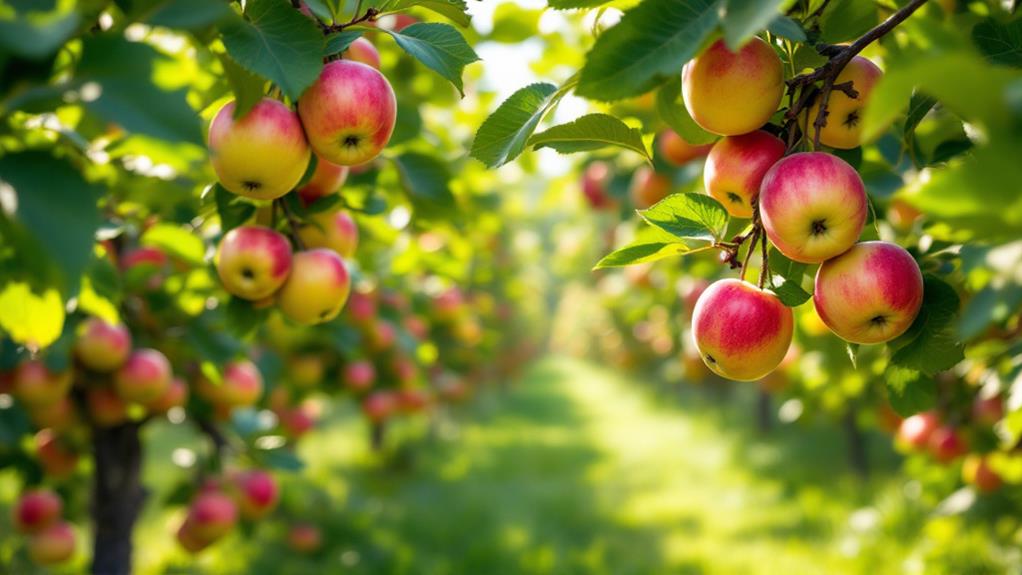
When exploring native apple varieties, you'll find that the crab apple (Malus coronaria) stands out as the only apple species indigenous to North America. Known for its small, tart fruits, the crab apple plays a unique role in the landscape of apple varieties. Unlike the sweet apples you might be familiar with, crab apples offer a distinct, tangy flavor profile that Native Americans historically utilized. They made cider and used these apples as a valuable food source.
Crab apples aren't just functional; they're also decorative. Many people use them in ornamental landscaping due to their beautiful blossoms and small, colorful fruits. These trees add a touch of natural beauty to gardens and parks, showcasing their resilience and adaptability.
Though most apples you see in North America today aren't native, the crab apple holds significant importance in apple breeding. Its genetic traits contribute to the development of new varieties, offering disease resistance and other beneficial characteristics. While the U.S. boasts over 2,500 cultivated apple varieties, thanks largely to European introductions, the native crab apple remains an essential piece of the apple puzzle, demonstrating the rich diversity and adaptability of this beloved fruit.
Cultural Significance
Many have noticed that apples carry deep cultural significance across different societies and times. You've likely encountered apples in numerous stories, like the tale of Adam and Eve, where the apple symbolizes temptation and villainy. This fruit doesn't just represent mischief, though. In Norse mythology, apples are symbols of energy and immortality, as the goddess Iðunn provided them to guarantee the gods' eternal youth. These stories show the apple's assorted cultural roles, ranging from sinister to life-giving.
Apples also play an important part in American identity, despite the phrase "as American as apple pie" originating in England. This expression reflects the deep-rooted cultural connection between apples and American tradition. Moreover, apples have long been associated with education and knowledge. During frontier times, students gifted apples to teachers as tokens of appreciation.
In everyday language, apples symbolize health and wellness, highlighted by the popular saying, "an apple a day keeps the doctor away." This enduring proverb underscores their cultural significance beyond legends and traditions.
- Apples represent temptation in literature.
- Norse myths link apples to immortality.
- Apples symbolize American identity.
- Historically, apples were gifts for teachers.
- Proverbs highlight apples as health symbols.
Apple Pie History

Few desserts carry as much cultural weight as apple pie, a dish that actually originated in England during the 1300s. Back then, sugar was a luxury item, so early versions of apple pie didn't include it. The crusts, often inedible, served mainly as a vessel for the filling rather than a tasty part of the dish. The initial known recipe appeared in a 1381 English cookbook, featuring spices like cinnamon and ginger. These spices added layers of flavor, compensating for the lack of sweetness.
As time went on, apple pie's expedition across the Atlantic led to its transformation into a quintessential American dessert. By the 19th century, the phrase "as American as apple pie" emerged, symbolizing the dish's growing popularity across the United States. The availability of sugar and improvements in baking techniques made the apple pie that we are familiar with today—a sweet, flaky delight—possible.
Now, apple pie holds a revered spot in American cuisine. It's a staple at Thanksgiving and other festive gatherings, cherished for its comforting taste and nostalgia. So, when you bite into a slice of apple pie, you're not just enjoying a dessert; you're savoring centuries of history and tradition.
Nutritional Facts
Apples pack a lot of nutrition into a small package, making them an excellent choice for a healthy snack. With just 95 calories in an average-sized apple, they're perfect for keeping your calorie intake in check. Despite their low-calorie count, apples are a great source of dietary fiber. A medium apple provides about 4 grams of fiber, which is 17% of your recommended daily value. This fiber helps with digestion and can keep you feeling full longer.
While apples are not packed with high amounts of vitamins, they do contribute to your Vitamin C intake. It's significant to mention, though, that a 100-gram apple contains less than 10% of your daily recommended intake for most vitamins and minerals. However, their high water content (about 85% of their weight) makes them hydrating and invigorating.
Here are some quick nutritional facts about apples:
- Low in calories (approximately 95 per apple)
- Contains about 4 grams of fiber
- Provides less than 10% of daily vitamins and minerals
- 85% water content for hydration
- Limited impact on reducing doctor visits
Incorporating apples into your diet is a tasty and healthful choice, just don't expect miracles!
Apple Cultivation
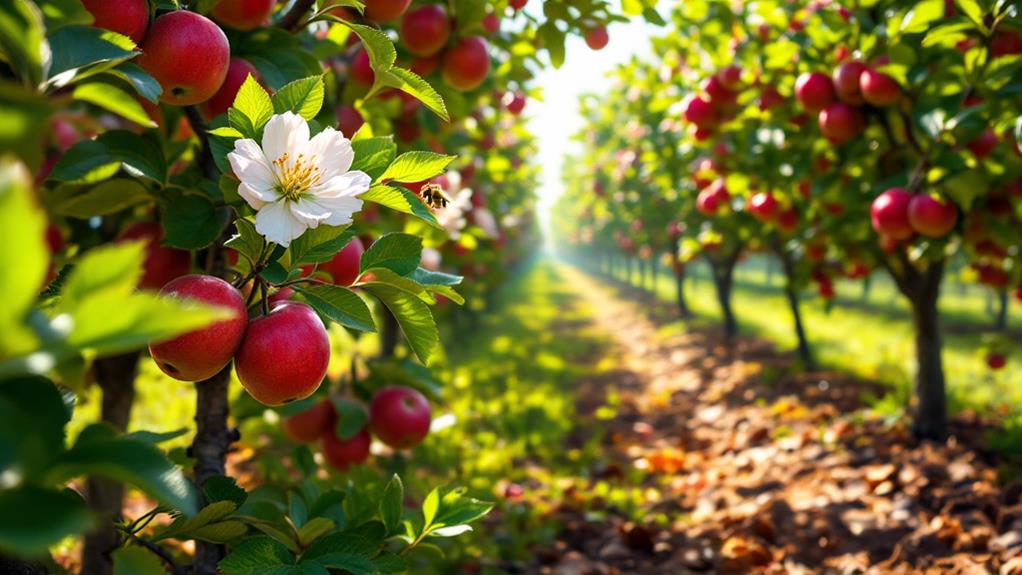
In the world of pomology, apple cultivation demands both science and art to yield bountiful harvests. You'll find that apple growing isn't just about planting a tree and waiting. It requires a deep understanding of how different varieties thrive and the conditions they need. Typically, apple trees take anywhere from 4 to 10 years to reach full production, depending on the variety and the environment where they're grown.
Washington State stands out as a leader in apple production in the U.S., contributing over 60% of the nation's apples. They cultivate these fruits on more than 175,000 acres, showcasing the scale and precision involved in apple growing. Apples flourish in temperate climates with well-drained soil, and they need careful management of sunlight, water, and fertilizers. This attention guarantees that each tree produces the best possible fruit.
When September and October roll around, it's prime time for apple picking. Many farms open their orchards to visitors, offering over 20 different varieties to sample and enjoy. So, regardless of whether you're a seasoned grower or a curious picker, apple cultivation offers a rewarding expedition from blossom to harvest.
Early Consumption Evidence
Long before apples became a staple in modern diets, they played a significant role in ancient civilizations. Early consumption evidence traces back to 6500 B.C., revealing that apples have been a part of human nutrition for thousands of years. This dates back to when the earliest domesticated varieties are believed to have originated in Kazakhstan, a region where wild apples still flourish today. Archaeological findings show that apples were a dietary staple for ancient Greeks and Romans, demonstrating their dietary importance.
Historical texts from diverse cultures highlight apples as an essential food source, emphasizing their significance across different periods. As trade routes like the Silk Road expanded, apples spread from their origins to Europe and the Americas, becoming a key element in the global diet of early humans. Their expedition underscores the influence apples have had on human history and nutrition.
Here's a fascinating snapshot of apples' enduring legacy:
- Evidence of apple consumption dates back to 6500 B.C.
- Originated in Kazakhstan, where wild apples still grow
- Staple in ancient Greek and Roman diets
- Mentioned in historical texts worldwide
- Spread globally via trade routes like the Silk Road
These points highlight apples' timeless role in human consumption.
Fun Apple Activities
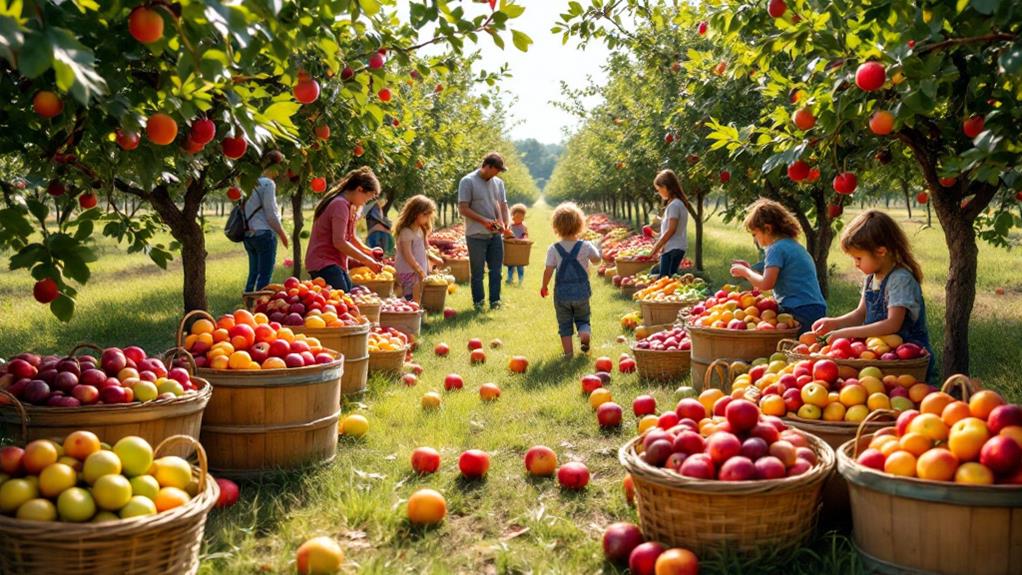
Apple enthusiasts have plenty of engaging activities to enjoy, showcasing the fruit's versatility and cultural charm. Have you ever tried apple bobbing? It's a classic Halloween game where you aim to grab floating apples using only your mouth. The apples float thanks to their 25% air content, making this both a challenging and entertaining activity.
Visiting an apple orchard is another fantastic way to plunge into fun apple activities. You can pick from over 20 different apple varieties, each offering a unique taste and texture. It's a hands-on experience that lets you connect with nature while learning about your favorite fruit.
Apple festivals across the U.S. take the excitement to another level. They often host pie-eating races and cider tastings, allowing you to celebrate apples in a communal setting. These festivals also offer educational workshops on apple cultivation and preservation, enriching your knowledge and appreciation of apples.
Don't forget about homemade apple crafts. Creating apple stamps or dried apple ornaments provides a creative outlet that extends beyond just eating the fruit. Regardless of you're crafting or participating in festivals, these fun apple activities make apples an even more delightful part of your life.
Culinary Uses
In regards to culinary versatility, apples are a true powerhouse. These fruits effortlessly improve both sweet and savory dishes, making them a staple in many kitchens. If you're baking a classic apple pie or tossing together a Waldorf salad, apples bring a revitalizing crunch and sweetness. Their culinary uses don't stop there, though. You can dry them, can them, or whip them into applesauce, allowing you to enjoy their flavor year-round.
Here are some creative ways to use apples:
- Apple Burgers: Try a vegan twist by incorporating apples into your burger patties.
- Apple Cider: Craft a gallon of this delightful beverage with about 36 apples.
- Baking: Use Granny Smith or Fuji varieties for pies and tarts, as they maintain texture and flavor under heat.
- Salads: Add thin apple slices to salads for an extra layer of crunch and sweetness.
- Snacks: Dried apples make for a healthy, on-the-go snack option.
Economic Impact

Beyond their culinary versatility, apples also play a crucial role in the economy. You might be surprised to learn that apples are the second most popular fruit in the United States, greatly contributing to the agricultural economy. This popularity enhances both local and national markets, especially in regions like Washington State, which produces over half of the U.S. apple supply. With about 175,000 acres devoted to apple orchards, Washington's apple industry is a powerhouse, creating seasonal employment opportunities in orchards and packing facilities, which helps sustain local communities.
Globally, apples have a considerable economic impact, with production reaching 86 million tonnes in 2020. This massive output underscores not only their popularity but also their significance in international trade. Washington apples, for instance, are a major export product, shipped to 60 countries worldwide. This global reach not only enhances international trade but also strengthens the U.S. economy by bringing in foreign revenue and supporting American jobs across the supply chain.
Common Apple Myths
Ever wonder why so many myths surround apples? These juicy fruits seem to attract a bunch of misconceptions. Let's bust some common apple myths so you can enjoy apples with a little more knowledge.
- Myth: All apples are sweet. In truth, apples come in a range of flavors. While many are sweet, varieties like Granny Smith offer a tart taste that's perfect for baking.
- Myth: Apple seeds are highly toxic. You'd need to eat about 200 seeds for any toxic effect. So, while it's good to avoid them, they're not as dangerous as you might think.
- Myth: Apples float because they're light. Actually, apples have a composition that includes 25% air, which is why they float in water.
- Myth: Apples are solely an American fruit. Believe it or not, apples originated in Kazakhstan and have a rich history across many cultures.
- Myth: An apple a day keeps the doctor away. A 2015 study debunked this belief, showing no significant impact on doctor visits.
Environmental Benefits
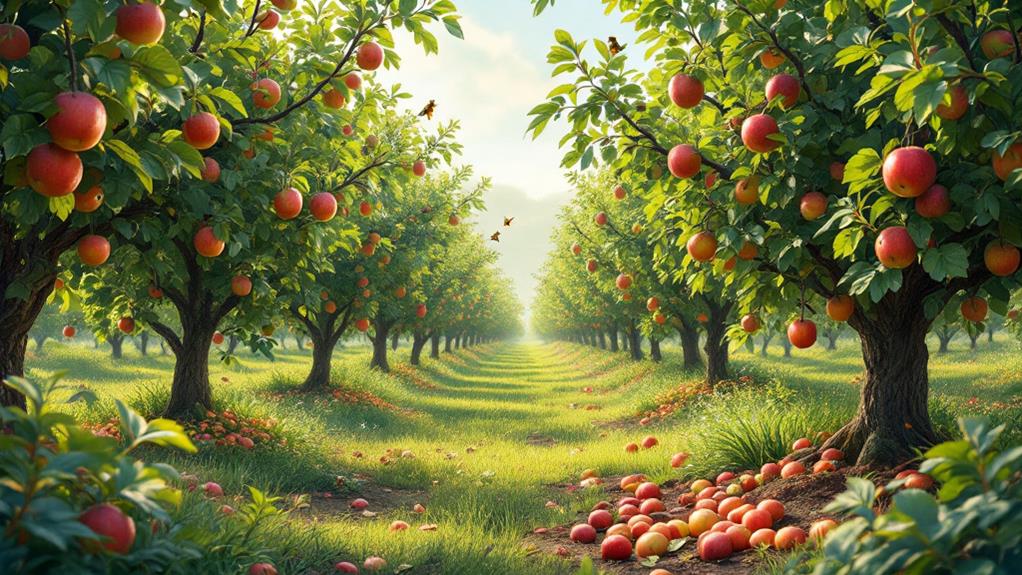
Apple orchards are more than just picturesque landscapes; they play a vital role in supporting our environment. By providing habitats for diverse species, including key pollinators like bees, these orchards improve local biodiversity. When you see an apple orchard buzzing with life, know that it's not just producing delicious fruit, but also sustaining ecosystems. Sustainable farming practices in apple cultivation further amplify these environmental benefits. By reducing pesticide use, you promote healthier ecosystems and enhance soil quality, creating a thriving environment for countless organisms.
You might not realize it, but apple trees are also doing their part to fight climate change. Through carbon sequestration, these trees absorb carbon dioxide from the atmosphere, thereby helping to mitigate climate change. Choosing organic apple farming methods is another way to support environmental health. By minimizing chemical runoff and using natural fertilizers, organic farming nurtures the earth, preserving it for future generations.
Moreover, when you buy locally sourced apples, you help reduce the carbon footprint associated with transportation. This supports a more sustainable food system and guarantees that the apples you're enjoying are as fresh as they are eco-friendly. So, next time you bite into an apple, remember its positive impact on the environment.
Health Advantages
Bite into an apple, and you're doing more than just enjoying a crisp snack; you're nourishing your body with a powerhouse of nutrients. Apples are packed with dietary fiber, offering around 4 grams per medium-sized apple. This fiber supports your digestive health, keeping things moving smoothly. But that's not all—apples are rich in antioxidants like quercetin and procyanidins. These beneficial compounds can help reduce the risk of chronic diseases, including heart disease and certain cancers.
When you regularly include apples in your diet, you're also giving your heart some love. These fruits can help lower cholesterol levels and blood pressure, contributing to improved heart health. Plus, with only about 95 calories per medium apple, they're perfect for weight management and healthy snacking. The high water content—approximately 85%—keeps you hydrated and can even help control your appetite, making apples a smart choice for weight loss efforts.
Here's why apples are a healthful enhancement to your diet:
- Rich in dietary fiber
- Loaded with antioxidants
- Supports heart health
- Low in calories
- High in water content
Embrace these health advantages by making apples a staple in your diet!
Apples in Popular Culture
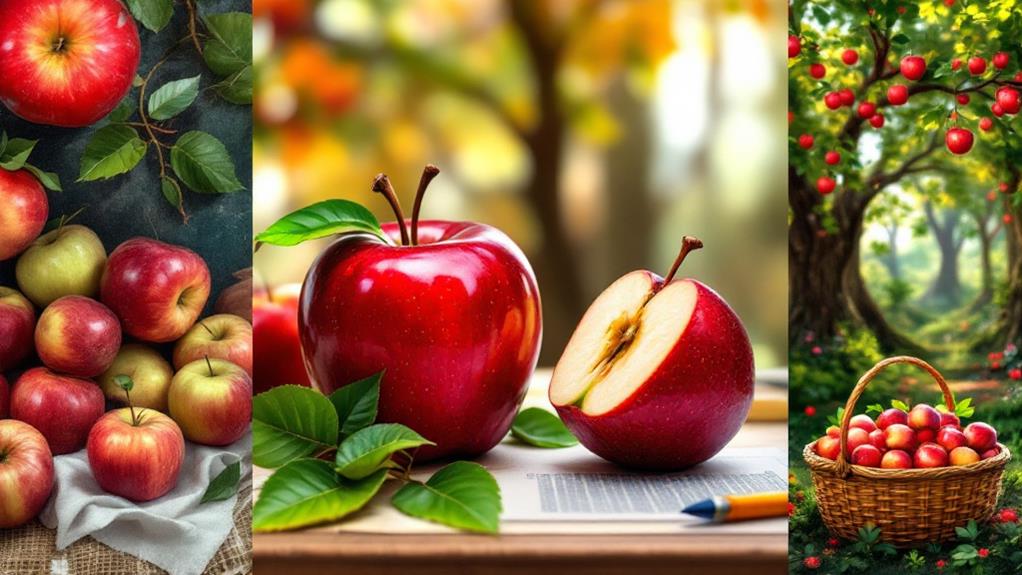
Throughout history, apples have woven themselves into the fabric of popular culture, appearing in everything from classic tales to modern idioms. Think about "Snow White," where the poisoned apple creates a crucial plot twist. This iconic fruit isn't just for fairy tales; it's also a staple in American culture. The phrase "as American as apple pie" underscores its importance, despite apples originally hailing from England.
In movies and advertisements, apples often symbolize health and knowledge, making them the go-to visual for wholesome eating. When you see an apple, you might think of a fresh start or smart choices. Remember the phrase "how do you like them apples?" It originated in 1895 and has become a popular idiom for expressing triumph or sarcasm. This saying shows how deeply apples have rooted themselves in everyday language.
Folklore also celebrates apples, with stories like Johnny Appleseed, who became a folk hero for spreading apple trees across the United States. His tale isn't just about planting seeds; it's about nurturing growth and prosperity. Clearly, apples in popular culture are more than just a fruit—they're a symbol of tradition and liveliness.
Technological Innovations
With advances in agricultural technology, the apple industry is experiencing a significant change. Technological innovations are reshaping how apples are grown, stored, and processed, leading to better yields and quality. Precision farming and smart irrigation have transformed apple cultivation by optimizing resource use, ensuring that each tree gets the exact amount of water and nutrients it needs. This not only enhances productivity but also improves the quality of the fruit.
Genetic research is another game-changer, focusing on enhancing disease resistance in apple varieties. You'll find that healthier crops reduce the need for pesticides, making apples safer and more sustainable. Furthermore, innovations in storage techniques, like controlled atmosphere storage, extend the shelf life of apples, allowing you to enjoy fresh produce year-round.
Drones have entered the orchards too, changing monitoring and management practices. They provide real-time data on crop health and irrigation needs, helping farmers make informed decisions. New processing methods have also emerged, offering diverse apple-based products, from fresh-cut snacks to value-added items like sauces and juices.
Here are some technological innovations reshaping the apple industry:
- Precision farming and smart irrigation
- Genetic research for disease resistance
- Controlled atmosphere storage
- Drone technology for monitoring
- New processing methods for apple products
Festivals and Events

As technology propels the apple industry into the future, communities celebrate its rich traditions through lively festivals and events. Apple festivals are scattered across the United States, offering a colorful tribute to the harvest season. When you attend one of these festivals, you'll find yourself engaged in activities like apple picking, pie-eating contests, and cider tastings. These events do more than just entertain; they highlight the hard work of local apple growers, promoting their products and elevating regional economies.
At these engaging festivals, you'll often encounter educational workshops that investigate apple cultivation and cooking. Whether you're an aspiring gardener or a culinary enthusiast, there's always something new to learn about apples. These workshops provide valuable insights, improving your appreciation for this beloved fruit.
Apple festivals also draw in tourists, which helps to increase local tourism. With live music, crafts, and family-friendly activities, these festivals are a hit among community members and visitors alike. They offer the perfect opportunity to examine the impressive diversity of apple varieties available in each region. So, next time you're looking for a fun, educational outing, consider visiting an apple festival near you.
Preservation Techniques
With regard to preserving apples, there are several effective techniques that guarantee this beloved fruit remains fresh and flavorful. You can start by considering canning, a method that seals apples in jars to prevent spoilage and extend their shelf life. Refrigeration is another straightforward approach; just store apples in a cool, dark place to keep them crisp longer. If you're looking to enjoy apples over a prolonged duration, dehydrating them by removing moisture works wonders while maintaining their taste and nutrients.
Another fantastic preservation technique is freezing, which locks in both taste and texture. This method is perfect if you plan to use the apples in smoothies or baked goods later. Don't overlook apple cider vinegar either, as it can serve as a preservative that not only improves flavor but also offers mild antimicrobial benefits. Here's a quick rundown of these techniques:
- Canning: Seal apples in jars to prevent spoilage.
- Refrigeration: Store in a cool, dark place.
- Dehydrating: Remove moisture for long-term storage.
- Freezing: Retain taste and texture for future use.
- Apple cider vinegar: Flavor enhancer and antimicrobial agent.

